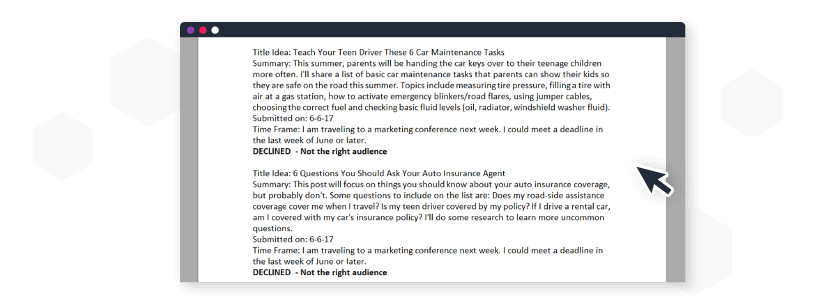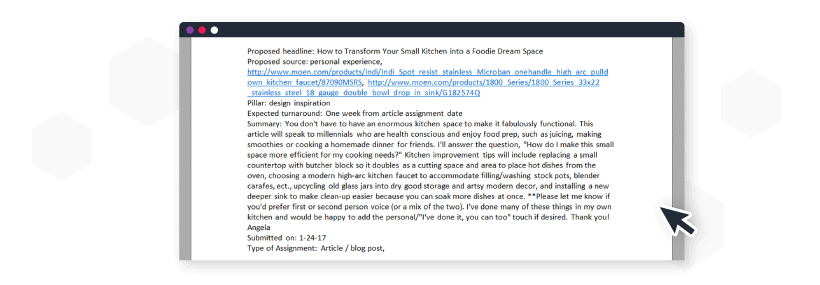All-star writers pitch current and potential clients weekly. Reaching out and proposing ideas shows interest, dedication and foresight into a brand’s mission. Plus, it proves you’re a go-getter.
When culling through freelancers, marketers want self-starters who see projects through to completion. Pitching timely, on-target ideas makes you stand out.
But, what exactly goes into freelance pitching? There’s ample background work to do before typing up that succinct pitch paragraph or two.
Warm up: Before you pitch, do your homework
Settle into your keyboard and look at the publication you plan to pitch. Browse the website. Read the blog. Research the brand’s vision and mission. Look beyond the words. Not only do you want to familiarize yourself with the topics they’re publishing, you also want to take note of the formatting and style.
What tone is reflected in the writing? Are they using first-person voice? What types of photos or graphics do they prefer? Are they using bullet points, quotes and subheads to break up the text? Your pitch should reflect this overall approach.
That means you need to think of an uncommon angle or hook to launch into the subject matter. If the client allows first-person voice or a storytelling approach, consider interjecting a vignette from your life to make the content instantly relatable to the audience. Or, find a fact that would make readers do a double take or become so curious that can’t help but click your headline.
Now, let’s get busy.
At the mound: Writing your article pitch
Pitching isn’t one-size-fits-all. Each approach will vary per client, since some ask for specialized information such as which category, audience or campaign you’re targeting. This template is a general guideline. Customize it to fit the requirements laid out by the client you’re pitching.
- Proposed Article Title: Create something catchy that could be used for the headline. Keep keywords and requested subjects in mind as you craft this section. Sometimes you can include two titles, to show various directions the topic could go.
- Suggest Keywords: Although most marketers will generate keywords after accepting a pitch, do a little leg work and make suggestions. Sometimes a client will ask for pitches based on keywords they hope to target. If that’s the case, include them here.
- Audience: List the specific persona or level of reader here. For example, for an automotive repair client, indicate newbie, car enthusiast or auto expert on each pitch.
- Summary: Keep this concise. Pitch reviewers simply don’t have time to read more than a paragraph or two. Focus on the angle you’re taking and summarize the key points you plan to make. Include a list of subheads to indicate the article flow and topics all at once. And don’t underestimate the power of a good lead — yes, even in a pitch.
- Turnaround Time: Note the approximate amount time it would take you to complete the assignment once your pitch is accepted. Giving the client an estimated turnaround time helps them prioritize. It also signals to them that you’ve thought through your idea — and can deliver it.
Play ball: Pitching in action
Let’s see this game in action. Here are four freelance pitching examples based on actual communication we’ve had with various clients. A few details are vague on purpose due to client confidentiality. Some of the pitches were picture-perfect home runs, others were embarrassing foul balls.
Knocking it out of the park
At the start of the year, we caught up with a content marketing specialist we work with frequently. During our candid conversation, she asked a few tough questions related to successfully collaborating with freelancers.
Bells went off! With her consent, we decided her questions would be perfect for a blog post on my website, Web Writing Advice. Her ideas ended up generating not one, or two, but three blog posts filled with actionable information. We both received a great response to the collaboration, so we turned the tables.
We pitched the idea to her to do a reverse blog post. We asked if we could send her a list of questions inquiring about how writers can successfully partner with marketers. She thought it was a fabulous idea, and this collaborative blog post materialized. The partnership generated interest for both of our businesses, making it a win-win!
Benching my ideas
Earlier this spring an automotive parts store reached out to us via email to create content for their car-focused blog. In the past we’ve tackled articles relating to auto insurance, car safety and a few minor DIY repair projects, so we felt confident in taking on this opportunity. The editor asked us to send over a few pitches, so we did.
We reviewed the editorial guidelines and content strategy. We browsed the website. We read about cars. We even took notes to help the information stick. But, we were still off my game.
We’ve since started brainstorming ideas directly with one of the editors to catch the subtle nuances of what this client really wants and needs. Thankfully, we’ve had a few pitches accepted since this string of rejections.
Being a team player
Being ready to collaborate and develop a pitch together with a client is essential. Sometimes you have to go into a potential assignment knowing you don’t have all the pieces to complete the work.
We sent a pitch to a client, Moen. They asked for a lifestyle topic revolving around the kitchen, with the opportunity to give a nod to their fixtures. We sent over this pitch, it was accepted and we wrote the post.
As we were editing and polishing the piece, the client decided which products they wanted to feature, based on my content. We worked back and forth over a messaging system to fine-tune my ideas and her branding needs to create a solid piece.
Time out: Waiting for a pitch reply
Freelance pitching can feel like you’re slogging through extra innings as you wait to hear back. There is no standard time frame for pitch approvals or rejections. Blog post pitches can be accepted in hours, and magazine pitches have taken months.
When you do hear back, don’t take rejection notices personally. Sometimes an idea is incredible, but it arrived at the wrong time, after the content budget has been cut, a campaign has been delayed or the editorial staff decided to switch gears and try a new topic — all instances beyond your control.
Ready to pitch?
So, are you ready to play ball? Wind up those ideas you can reach out to your favorite publishers with an engaging, well-formulated idea. And if you want to work with a partner to not only help, but also do some pitching for you, join our Talent Network.







